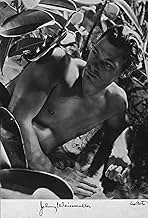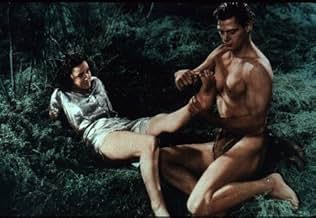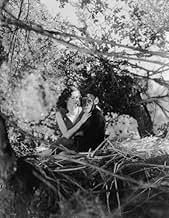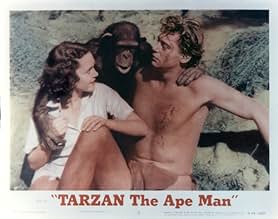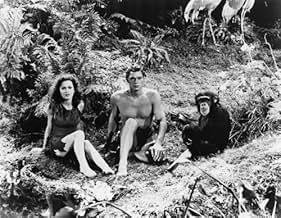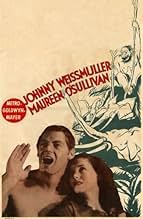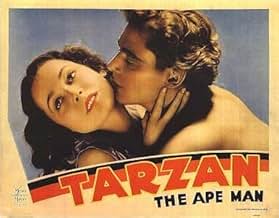Ein Mann, der im afrikanischen Dschungel von Affen großgezogen wurde, ist nun der Herrscher und Beschützer der wilden Tiere - ein Held, der den Namen Tarzan trägt.Ein Mann, der im afrikanischen Dschungel von Affen großgezogen wurde, ist nun der Herrscher und Beschützer der wilden Tiere - ein Held, der den Namen Tarzan trägt.Ein Mann, der im afrikanischen Dschungel von Affen großgezogen wurde, ist nun der Herrscher und Beschützer der wilden Tiere - ein Held, der den Namen Tarzan trägt.
- Regie
- Drehbuch
- Hauptbesetzung
- Auszeichnungen
- 2 Gewinne & 1 Nominierung insgesamt
- Evil Dwarf
- (Nicht genannt)
- Evil Dwarf
- (Nicht genannt)
- Evil Dwarf
- (Nicht genannt)
- Evil Dwarf
- (Nicht genannt)
- Ape
- (Nicht genannt)
- Evil Dwarf
- (Nicht genannt)
- Bird Creature
- (Nicht genannt)
- Evil Dwarf
- (Nicht genannt)
- Evil Dwarf
- (Nicht genannt)
- Ape
- (Nicht genannt)
Empfohlene Bewertungen
This movie made me feel like a young boy, craving excitement and adventure. This first installment in the MGM Tarzan movies delivers big time. Yes, the special effects and interweaving of the stock footage looks a bit dated, but remember that this film was only made three years after the first "talkie" (i.e. a sound picture, not a silent movie). There are certain techniques that obviously stem from the silent movie days. But to me, this just adds to the charm.
The animal footage is excellent. For the first time in a long time, I was actually on the edge of my seat during a movie. The CGI effects today are amazing, but they're so overdone (most of the time). The thrills and suspense in "Tarzan" are heightened, because you know everything you see is physically tangible, not an actor reacting to a green screen.
I still don't know how they did some of those scenes without anyone getting hurt. Swinging from the treetops, wrestling with lions, wrestling with leopards, being chased by wild animals--all of these things make for great entertainment and adventure.
I should also mention that the relationship between Tarzan and Jane is one of the most captivating I've ever seen in a movie. It's very understated, yet very sexy. Today, they would ruin the story by making the couple have sex after five minutes. But because the sexual chemistry is only hinted at, the entire relationship is one of Jane flirting and Tarzan pursuing. It just builds and builds. This romance actually has excitement to it. Definitely one of the best screen romances of all time.
Despite a few minor shortcomings in the special effects of the time, this is a thrilling movie. Great adventure, great excitement, great entertainment. Don't miss it!
A success? Thalberg created a legend!
Utilizing MGM's vast library of stock footage (primarily from 1931's TRADER HORN), a primordial Africa that was more pulp fiction than reality was created on the back lot, and veteran British character actor C. Aubrey Smith and 20s matinee idol (and future 'Batman' regular) Neil Hamilton were introduced, as James Parker and Harry Holt, adventurers questing after the legendary 'Elephants' Graveyard'. The arrival of Parker's daughter, Jane (O'Sullivan), a free-spirited, raven-haired beauty, complicates matters, but her stubborn refusal to lease, and confidence with the natives (shown as rear projections behind Smith and O'Sullivan) finally win the two men over, and soon the trio, accompanied by whip-induced native labor, are on safari.
When a dying porter points the way to the Escarpment, a massive 'taboo' mountainous plateau protecting the Graveyard, the party has the missing piece to the puzzle, and begin an arduous climb to the top. (How a massive mountain range could be hidden, for so long, is not explained). After losing a porter, and nearly Jane, on the steep climb, the summit is achieved, and the famous Tarzan yell (a combination yodel/howl, created by MGM's sound department), is first heard. A treacherous river crossing, featuring stock footage of hippos and crocodiles, then costs the safari more bearers, with another yell saving their lives.
All this leads up, of course, to Johnny Weissmuller's first appearance as Tarzan, observing the party from the trees. He is simply magnificent...tanned, slim, smoothly-muscled (as opposed to the brawny body builders later cast in the role) and nearly naked. He soon kidnaps Jane (he may be ignorant, but he's not dumb!), and the incredible chemistry between the pair is exhibited for the first time. While initially terrified of the savage (particularly as he pulls off her clothing parts to examine them), he doesn't 'have his way' with her, and she realizes he is far more sensitive than she'd assumed.
Holt kills the ape guarding Jane (one assumes it is Kala, ape 'mother' of Tarzan, in the ERB books), and Tarzan screams in anguish at his loss. Displaying the racism prevalent in so many 30s films, Jane tries to defend her erstwhile kidnapper to her father ("He's WHITE!"), but the two hunters aren't buying it, and soon wound Tarzan, himself. Jungle animals spirit the bleeding jungle lord away...and Jane is soon at Tarzan's side, bandaging his head, and looking lustily at the big lug! When he recovers, the pair consummate their passion (in a scene tastefully off-camera), and are swapping names ("Jane...Tarzan...Tarzan...Jane").
Tarzan returns Jane, and walks away, despite her pleas to return to civilization with them. The safari is soon captured by a height-challenged native tribe ("Are they Pygmies?" Jane asks; "They're dwarves," her father replies...uh, whatever...), and a gruesome scene ensues of the surviving members being lassoed and dropped into a pit with a giant gorilla (a not-quite convincing guy in an ape suit). Holt is knocked unconscious, Parker is mortally injured, Cheeta is tossed against a wall, and Jane swoons in the gorilla's arms (shades of KING KONG), then Tarzan busts in, to kill the ape and save them all. As the ever-available stampede of elephants mash the dwarves into pulp, Tarzan leads the dying Parker, Jane, and Holt to the 'Elephants' Graveyard', where Jane's father passes away. Holt returns to civilization (he would return in the sequel, TARZAN AND HIS MATE) and Tarzan, Jane, and a recovering Cheeta start an exciting new life together!
Yes, the story is unintentionally campy, the 'apes', and animal fights, unconvincing, and there is blatant racism throughout the film. But as sheer entertainment, Depression-era audiences were enthralled. Weissmuller and O'Sullivan conveyed the kind of eroticism that pre-Code Hollywood was notorious for (and would reach even greater heights in the sequel), the action sequences were spectacular, and a new MGM franchise was born, that would produce six more films over the next nine years.
Thalberg had again proven why he was considered the film industry's resident genius!
This was in fact the "original" of a long series of Tarzan movies starring Weissmuller and O' Sullivan that were made by Metro-Goldwyn Mayer,which in turn made Tarzan a hot commodity and its studio a Hollywood producing powerhouse of great entertainment. Dubiously faithful to the Edgar Rice Burroughs story about the humble beginnings to where Tarzan is introduced has been remade numerous times,but this is the 1932 original where Johnny Weissmuller and Maureen O'Sullivan bring a class of style of wit to the roles and the results are absolutely brilliant from beginning to end. Then in 1934,MGM made a sequel entitled "Tarzan And His Mate" which was the second entry in the lavishly produced MGM Tarzan series. Weissmuller and O'Sullivan cohabit in an unmarried bliss before the Hays Code of the era moved them into a treehouse with twin beds. There is also the swimming scene,which until now has been restored from the original print which has been banned for years until MGM reissued this scene back into the film. The scene where Maureen O'Sullivan is swimming with Weissmuller,completely nude was in its day very noticeable and very restricted toward adult audiences. Among the challenges that they face in there private domain is against nasty white hunters,savage natives,angry elephants,hungry lions and maneating crocodiles.
"Tarzan Escapes",was the third entry in the series released in 1936. In this sequel,Jane(O'Sullivan)is tricked by evil hunters into abandoning her fairy tale life with Tarzan(Weissmuller). So the Ape Man sets out to reunite with is one true love,and as he sets out to get back with Jane,trouble ensumes. The third entry in MGM's successful Weissmuller/O'Sullivan series is still among the better Tarzan movies thanks to the leads,but the Hays Office made sure that Jane was wearing a lot more clothes this time around since this was also aimed toward adult audiences. The series from this point takes a three-year hiatus. Then in 1939,the fourth entry in MGM's Weissmuller/O'Sullivan series went toward the kiddie fare with "Tarzan Finds A Son" which was family oriented material and a little more tamer than the first two installments. However,Weissmuller and O'Sullivan returned to their roles after three years with the addition of five year-old Johnny Sheffield as "Boy". He's an orphan whose awful relatives hope he stays lost so they can collect and inheritance. Tarzan and Jane fight to adopt the tyke and when the new family are captured by a wicked tribe only an elephant stampede and Tarzan's call of the jungle can save them.
Then in 1941,after a two year hiatus,the fifth entry in the series was really standard kiddie fare with "Tarzan's Secret Treasure". Tarzan saves an expedition from a savage tribe only to be repaid by having greedy hunters hold Boy and Jane hostage. They want Tarzan's help in finding a secret cache of gold hidden in the jungle. But Tarzan doesn't take kindly to threats against his family and teaches those evil-doers a lesson they'll never forget! This one was action-packed and it does show Weissmuller doing some of his own stunts. Then,in 1942,the last and final entry in the MGM Tarzan series titled "Tarzan's New York Adventure",marked Maureen O'Sullivan's final appearance as Jane. This one is so-so adventure with some very humorous moments when Tarzan meets the big city. When Boy is kidnapped by a evil circus owner,Tarzan,Jane and Cheta head out to rescue him.Then Tarzan shows off his jungle prowless by climbing skyscrapers and diving off the Brooklyn Bridge into the East River. This final Tarzan entry for both Weissmuller and O'Sullivan showcases some very interesting cameo appearances including one which features Elmo Lincoln,the screen's first Tarzan in a cameo appearance.
After the huge success of the Tarzan films for MGM,Johnny Weissmuller continue to played The Ape Man in six more films for RKO Pictures which began in 1943 and ended in 1948,where Weissmuller's final appearance as the Ape Man concluded in "Tarzan And The Mermaids",before he would venture into a new medium---television as "Jungle Jim" in the early-1950's. He also played "Jungle Jim" in several theatrical films for Columbia Pictures. As for actress Maureen O'Sullivan,after the success of the Tarzan films,she would go on to star in several films including "The Big Clock" and "Bonzo Goes To College" opposite Ronald Reagan and so many more. As for Johnny Sheffield,he would go on to continue the role of "Boy" in five more Tarzan films with Johnny Weissmuller until 1949,when he went on to star in more than twelve features as Bomba Of The Jungle under RKO Pictures and would continue that role on television.
The fuss over swimming champion Michael Phelps is nothing compared to what Johnny Weissmuller's celebrity was like. In the Roaring Twenties when each sport seemed to have an icon that became a legend, Weissmuller was that for swimming. The records he set in the Olympics stood for many years, with today's athlete conditioning methods I can only speculate what he could do today if he were alive and in his prime.
Still Louis B. Mayer was nothing if not cautious in protecting an investment in a non-actor to be a lead in a major film. He kept Weissmuller's dialog to grunts, guttural jungle utterings, and a few choice words that Maureen O'Sullivan as Jane teaches her new jungle man toy.
With tons of footage left over from MGM's African location film of Trader Horn, Tarzan The Ape Man had all the background needed to make the film look good. It's fairly obvious that when you see shots of Neil Hamilton and Maureen O'Sullivan they're shot against a background of real natives. They never got further to Africa than Toluca Lake in the shooting.
It's also obvious that Weissmuller couldn't act at all which was why he was only given grunts and dialog of one and two words. Later on he did become a competent enough actor. But quite frankly who cared when they saw him in a loin cloth.
Maureen O'Sullivan as Jane Parker comes to Africa to visit her father C. Aubrey Smith and she finds that Smith and his partner Neil Hamilton are planning an expedition into some unexplored territory in search of the fabled elephant's graveyard. A lot of loose ivory to be picked up there without the danger of actually trying to kill the beasts. Hamilton's interested in her, but when white jungle man Tarzan rescues O'Sullivan, Hamilton doesn't have a prayer.
Tarzan The Ape Man is still an exciting adventure film even to today's more sophisticated eyes. And Weissmuller and O'Sullivan's appeal as a romantic couple is timeless.
All right so they haven't got the dialog from Romeo and Juliet, who cares?
Wusstest du schon
- WissenswertesThe elephants used in the early Weissmuller films were not African but Asian elephants with African sized ears strapped on. This practice is still common because the Asian species is much more docile than the African. In later films the fake ears were abandoned altogether figuring no one would know the difference.
- PatzerWhile swimming across a river, Tarzan gives off his full Tarzan yell while his head is completely submerged under water.
- Zitate
Jane Parker: Thank you for protecting me.
Tarzan: Me?
Jane Parker: I said, thank you for protecting me.
Tarzan: [points at Jane] Me?
Jane Parker: No. I'm only "Me" for me.
Tarzan: [points at Jane] Me.
Jane Parker: No. To you, I'm "You."
Tarzan: [points at himself] You.
Jane Parker: No...
[Thinks for a second]
Jane Parker: I'm Jane Parker. Understand? Jane, Jane.
Tarzan: [points at Jane] Jane, Jane.
Jane Parker: Yes, Jane. And you?
[Tarzan stares]
Jane Parker: [points at herself] Jane.
Tarzan: Jane.
Jane Parker: [points at Tarzan] And you?
Tarzan: Tarzan. Tarzan.
Jane Parker: Tarzan...
- Alternative VersionenColorized version was available... and shown on TNT
- VerbindungenEdited into Tarzans Rache (1936)
- SoundtracksVoo-Doo Dance
(uncredited)
Music by George Richelavie
Arranged by Paul Marquardt & Fritz Stahlberg
Played during main title
Top-Auswahl
Details
Box Office
- Budget
- 652.675 $ (geschätzt)
- Weltweiter Bruttoertrag
- 72 $
- Laufzeit1 Stunde 40 Minuten
- Seitenverhältnis
- 1.37 : 1
Zu dieser Seite beitragen



